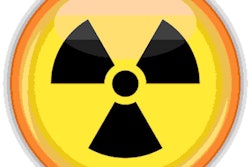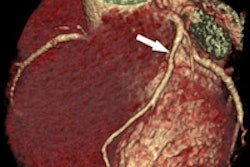
Researchers from Canada were able to cut radiation dose in CT studies of multiple anatomic regions with a simple solution: performing a single scan with a larger field-of-view, rather than combining two scans of smaller regions. The technique eliminated overlap in CT dose, according to data presented at a joint meeting of Canadian radiology societies.
The group from the University of Saskatchewan wanted to find ways to reduce radiation dose in CT scans and saw studies of multiple anatomic regions as a potential target, according to Dr. Evan Barber, a first-year general surgery resident. Barber spoke at a session of the Joint Congress on Medical Imaging and Radiation Sciences, which was organized by the Canadian Association of Radiologists (CAR), the Canadian Association of Medical Radiation Technologists (CAMRT), and two French-language associations in Quebec representing radiologists and radiation technologists, respectively.
"We wanted to look at our scan protocols to see if they could be optimized to reduce the amount of radiation received by patients, since radiation is linked to malignancy," Barber said in an interview. "We know that when we are scanning multiple regions with a CT scanner, there may be areas of double coverage in terms of anatomy depending on the protocols that are used. If we minimize these areas of double coverage, we can reduce the amount of radiation that patients receive."
Modifying protocols
Barber led a group that in 2010 began looking at patient radiation exposure levels in their health system. They modified their scanning protocols and then reviewed dose levels again in 2014 to see if radiation dose had decreased, Barber explained.
The researchers collected data for chest/abdomen/pelvis CT scans, as well as neck/chest/abdomen/pelvis studies. They included the number of scan segments, the total craniocaudal length of the chest segment, and the craniocaudal length of anatomic overlap between segments, along with the dose-length product (DLP) for each segment.
Barber and colleagues calculated the effective dose of radiation using the DLP values and looked to the literature for conversion factors. They also calculated what they termed "doubled doses," which were higher doses of radiation that resulted from anatomic overlap during scanning.
"We wanted to know the percentage of radiation that was unnecessary compared to an ideal single-pass dose," he said. "Ideally, we would reduce the number of individual segments in the scan to minimize the overlap. If multiple scans were necessary, we would try to reduce the amount of overlap."
They altered their CT protocols to minimize anatomic overlap at the three sites, Barber explained. Under the original protocol, chest/abdomen/pelvis images were obtained with two scan segments, including an individual chest scan and an abdominopelvic scan. Under the new protocol, these images were acquired with a single study by scanning a larger anatomical area.
Similarly, under the original protocol, neck/chest/abdomen/pelvis studies were obtained with three scan segments, while under the modified protocol, two larger scan segments were used, the neck being one and the chest, abdomen, and pelvis being the other. The researchers then collected data with the revised protocols, comparing radiation exposure between the original and revised versions.
The amount of unnecessary radiation because of double coverage fell from 12% to 0% with chest/abdomen/pelvis studies and from 25% to 8% with neck/chest/abdomen/pelvis studies.
"It's a straightforward and simple change to implement," Barber said. "It's not costly, and it would be available to any center. It's a simplified process for technologists."
When asked how the modified protocols affect radiologists reading the scans, Barber said no radiologists reported any difficulty with imaging interpretation using the modified protocols; indeed, "there are fewer scans for radiologists to review," he noted.




















